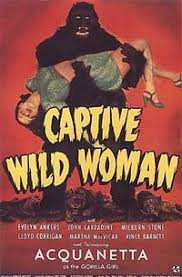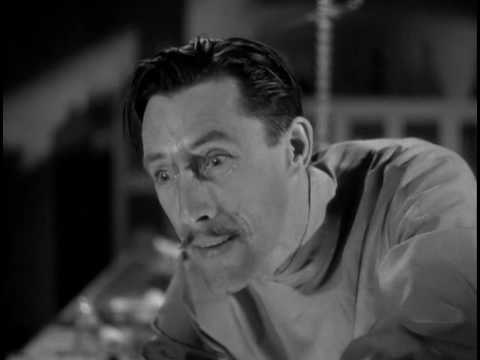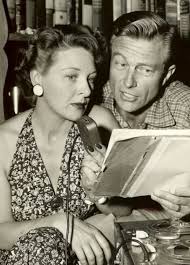IMDb meta-data is 1 hour and 1 minute, rated at 5.7 by 584 cinemitizens.
 Another lie from the marketing department, since as explained below the ape could not carry off that woman, for it was herself. Got it? Read on.
Another lie from the marketing department, since as explained below the ape could not carry off that woman, for it was herself. Got it? Read on.
Verdict: a masterclass is making something from nothing.
John Carradine, before he became a caricature of himself, is in top form as the scientist who goes on and on, and changes from a charming genius to a mad and bad scientist.

He finds a way in the script to transfer the secretions of glands from one animal to another. This transference leads to a transformation. The dog receiving rabbit secretions becomes a rabbit! ‘Would it work for Trumpettes,’ asked the fraternity brothers! ‘Could they be made human?’ Or is that too much even for a scriptwriter to conceive.
Suspend that disbelief and go along for the ride.
In the early stages of these experiments his findings, somehow, aid human patients. He publishes his work in learned journals. This being the first time in the Mad Scientist Genre I have seen where publications figure. He presses outward on the boundaries of knowledge, narrowing his eyes and lowering his voice. Can a nationally competitive grant be far away?
Then by chance through a new patient he goes to an animal circus and sees a very pliable stunt man in an ape suit. The idea hatches.
He will transfer human secretions into this ape, who then become a human woman. Stuntman to human woman, presents no problem for the scriptwriter. The transference drains, i.e., kills the human patient. ‘They have (unknowingly and involuntarily) sacrificed their pitiful lives for the advancement of knowledge,’ Carradine intones, as only he could. It is a small price (for someone else to) pay for his career.
Hmm. I might have believed it if he had said that they were killed to fatten his CV, meet his KPIs, or win a nationally completive NH&MRC grant. That would be credible in the world McKinsey has made.
Other mad scientists who play god usually have a purpose: sometimes they want make slaves of others, to make superhumans who reach the stars, or plumb ocean depths, vote Republican into eternity, or get tenure. Not in this case. He wants to do it because he can. Mad science for mad science’s sake. Nothing instrumental involved. Pure research!
Something from nothing? About a third of the short run time is excerpted from an earlier Universal movie called ‘The Big Cage’ (1933) about an animal circus, featuring Clyde Beatty (1903-1965) who was a remarkable lion tamer, animal trainer, and circus impresario. Director Edward Dymytryk cut and pasted these excerpts so well that the seams do not show. In this he was added by great lighting, make-up, and editing. Doc Adams was cast as the animal trainer because he resembled Beatty as he had been in that earlier film. All in all, the film is technically superb and the print I found on You Tube was clean and crisp.
The result is a rattling yarn. Carradine succeeds but finds a stinger at the end. Doc Adams cracks the whip. Evelyn Ankers, Martha Vickers, Fay Helm, and Acquanetta kept the fraternity brothers watching.
Evelyn was married to a personal favourite, Richard Denning, who was away at war when she made this film, hoping the yellow telegram would not come.
 Ankers and Denning together in the 1950s.
Ankers and Denning together in the 1950s.
Martha Vickers’s single line in the film is ‘Well, I…’ But she lies around comatose in a hospital bed. She was preparing for her role in ‘The Big Sleep’ (1946). Fay Helm injects some humanity when she tries to stop Carradine. Of Acquanetta the less said, the better, but her make-up and transitions set a new standard for the genre. She speaks not word one. Correct. Completely silent. Considering what she did to her few subsequent roles that was a good choice. It is said that she was difficult with whom to work. At the time and place, for a woman that was often code for not being sexually compliant.
The entrepreneurial Crash Corrigan (1902-1976) was the stuntman in the ape suit. An acceptable ape suit was expensive and time-consuming to make. Genre horror pictures were then by definition quick and cheap, so they had no time and no budget for such matters. Corrigan saw a market niche and made it his own and passed out business cards: ‘Have ape suit, will travel.’ He was in demand for about a decade for horror movies, commercials in cinemas and later on television, openings of stores and malls, extravagant Hollywood parties, USO tours, charity fundraisers, Trumpette conventions, and more.
Crash started out in B-Westerns where he did his own stunts. In time he concentrated on stunt work which he found more interesting and less taxing than remembering and delivering lines. He got the nickname ‘Crash’ as a college football player for his open field tackling, not for his automobile driving.
He showed entrepreneurial flair again when he bought a ranch in the Simi Valley and rented it out as set for movies, serials, and television shows. He also staged western shows there for tourists. Crash knew how to make cash.
John Carradine developed the habit early of taking any part he could get, because he wanted the money to pour into his Pasadena Shakespeare Company. And pour money into it he did, but in the end it failed, but by then he retained the habit of answering ‘Yes’ when a part was offered. See his subsequent career.
Edward Dmytryk (1908-1999) directed such movies as ‘Caine Mutiny’ (1954) and ‘The Left Hand of God’ (1955) both starring Humphrey Bogart. He worked his way up the pecking order, starting with B genre films like this and ‘The Falcon Strikes Back’ (1943) to ‘Cornered’ (1945) and on to ‘Crossfire’ (1947) and ‘Mirage’ (1965), for a total of fifty-six credits.
Born in Canada he was an orphaned juvenile delinquent in San Francisco who was proud of his Ukrainian heritage. He started working as messenger boy for a studio and then projectionist where he learned the technology, film editor to become the lead director for RKO’s A-Picture department.
He was imprisoned by HUAC for refusing to answer questions, being one of the Hollywood Ten used by that execrable body to publicise itself. His name and his father’s origins in Russia, made him an early and easy target, and his defiance made great copy for the vultures of the media and the Committee.
Skip to content
